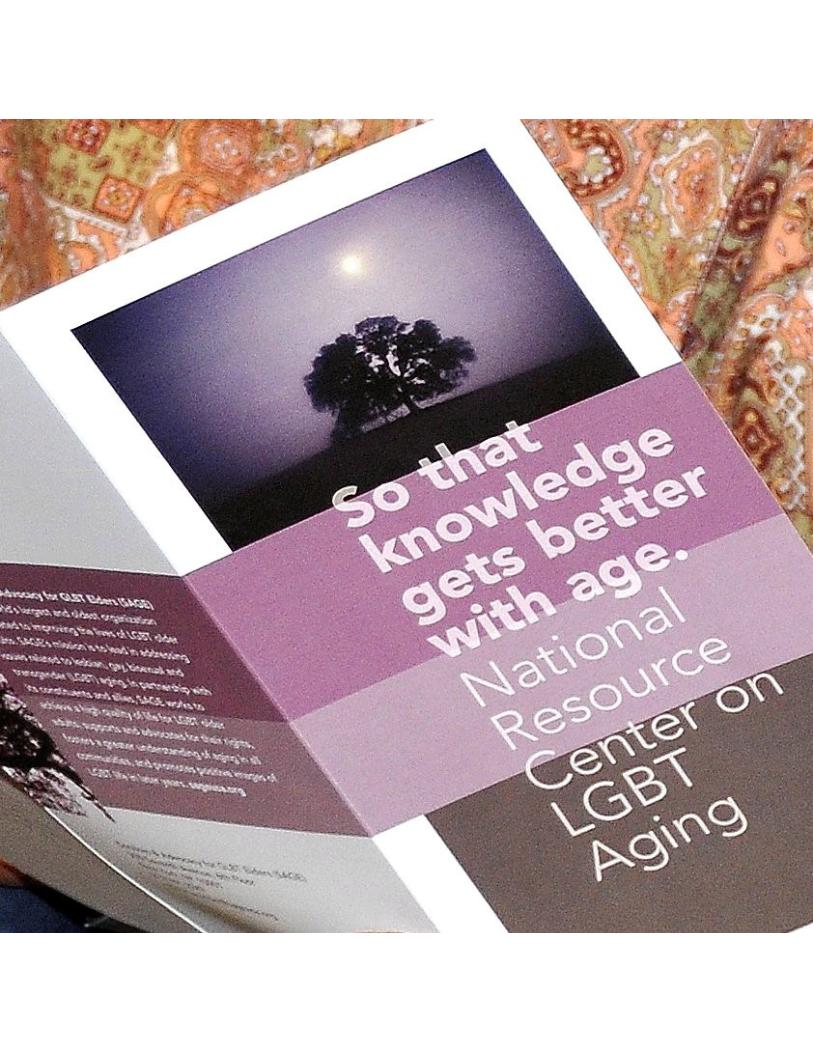Waking Up: LGBT in Old Age From a Provider’s Front Lines Perspective
March 2012 | Ellen Ensig-Brodsky
From Personal to Professional
There was a moment in my professional career that the reality of LGBT aging hit me.
I was working at a nursing home in Brooklyn as a U.S. Federal Long Term Care Surveyor, inspecting the operation and maintenance of the facility. I was the Registered Dietitian of the Federal Inspection Team. Accompanied by the Head Nurse, we would begin by visiting the patients’ rooms to explain that the inspection was mainly just a formality. One resident, an older woman in a wheelchair, stared right at me and in a loud, high-pitched voice yelled, “Are you a lesbian?”
Her words were like a knife cutting into my stomach, and for the moment I was speechless. “Oh,” I said quietly. “I will come back later so we can talk.” The head nurse took my arm, pulling me out of the room. “Don’t worry. That woman says the same thing to every female who enters her room." The nurse began laughing and I laughed too.
Only after we were further down the hall did her words fully hit me and my mind became flooded with questions. Why did that woman say that? Was she a lesbian? Had she been afraid to come out? Had she repressed her feelings throughout most of her life only to shout them out as she transitioned into senility? Had her daughter been a lesbian? Did she hate lesbians? Did she have some uncanny “sixth sense” about me?
I became overcome by even more thoughts and questions. How many old lesbians and gay men out there have wrestled with whether, or how, to “come out?” How could they meet other people like themselves? Did they need to spend nights and weekends in dim, smoky, downstairs bars? How, especially as they grew older, could they get proper health care or legal advice when an essential part of themselves—their sexuality and chosen families of lovers and friends—were a secret to the outside world?
Upon returning home that evening, I sat down with my partner, Nan. We joked about the “are you a lesbian?" incident, but then we realized it was urgent to explore the repercussions of aging service providers not knowing the truth about their closeted clients. We realized how vital it was that providers knew who their clients most important people were, especially those potentially responsible for their clients’ finances, health, and care decisions.
Nan, the director of a well-respected, busy senior center, and I determined that there was a need to develop a list of LGBT-friendly services, and that such a list should be widely available to LGBT seniors, and that education and training should be used to expand the number of culturally-sensitive service providers.
Moving From Concern to Action
As a result, we created the Pride Senior Network in 1995. Many of our friends were involved in the aging, health, and human service professions and with that, we were able to form a knowledgeable Board of Directors, obtain a 501(c)(3) designation from the I.R.S., and obtain funding from the N.Y. State Office for the Aging. Our first Pride Senior Network directory filled about 50 pages and covered mostly, but not exclusively, the New York area. The services listed related to advocacy, education, business, finances, investments, insurance, legal, health, real estate, religious, cultural, social activities, entertainment, travel, and dining. As membership increased and more service providers were anxious for listing in the directory, the Pride Senior Network grew.
We expanded our activities to educating government and service agencies through in-person presentations. An especially effective technique was the use of dramatic role playing. We acted out a senior showing signs of decline and the subsequent attempt of a professional to help. The first plot showed the provider (MSW, nurse, etc.) assuming that the client or patient was a married heterosexual and the provider attempting to contact the husbands, wives, and/or other legal relatives. We then showed how much more effectively help became when providers were aware of an LGBT relationship and the nature of chosen families.
In addition, we prepared, distributed and presented papers entitled “Barriers to Accessing Health Care, Legal and Financial Issues,” “Intergenerational Contributions to LGBT Chosen Families,” “Levels and Types of Homophobia,” and “An Analysis of Gay and Lesbian Supportive Environments.” We developed an alliance with the New York State Office for the Aging via a feature on their website called “Gay & Lesbian Concerns” including us providing “A Guide To Senior Housing – Critical Questions to Ask.” The US Administration on Aging also included our list of LGBT issues in their website’s “The Many Faces of Aging.” Finally, the N.Y. Long Term Care Community Coalition on Aging published our article “For Gay Residents – What is Quality of Care/Quality of Life?” We also contributed material to the American Society on Aging and the National Coalition on Aging.
We were featured speakers and participants in the National Gay and Lesbian Task Force’s “Creating Change” conferences, and held active membership in the Health and Human Services Network of Empire State Pride Agenda and the NY State Coalition for the Aging.
Letting Others Take the Reins
For a variety of reasons, the Pride Senior Network eventually needed to step back and encourage other organizations to wave the banner of LGBT aging. The advent of the Pride Senior Network was an exciting time! It was one sign of progress that after decades of being called sick misfits, the LGBT community was leading the way. We were finally being recognized by service providers in aging that we were creating caring families of choice, networking around the world, and proving that the deepest love had many roots evolving into the most beautiful of blossoms.
We seniors had lived through it all. With passion, concern, and care for one another, we have guided the way for the LGBT world of tomorrow.
Ellen Ensig-Brodsky, B.S., M.A. is a Certified Pastoral Counselor. She has served as a Director of Nutrition for the Momentum AIDS Project; a US Federal Long Term Care Surveyor; the President of the Manhattan Borough Wide Inter-Agency Council on Aging; and, as an active member of many advocacy groups including: the Manhattan Borough President's Senior Advisory Committee, the Long Term Care Community Coalition of NY, the Senior Issues Group of the LGBT Health & Human Services Network of Empire State Pride Agenda. Ensig-Brodsky earned her M.A. in Human Nutrition from New York University and graduated magna cum laude, with a B.S. in Economics and Marketing from New York University.

